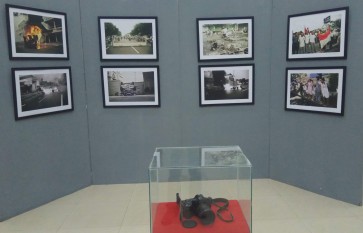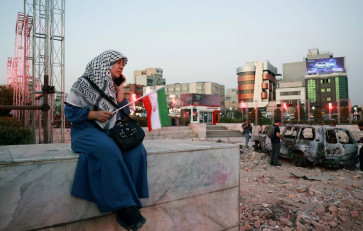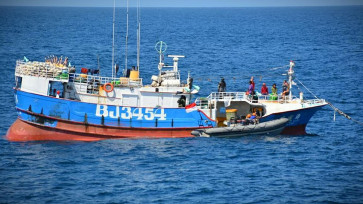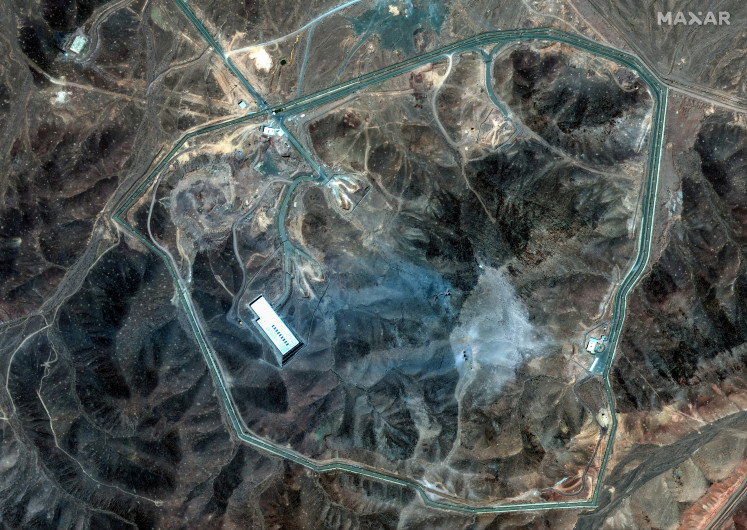Popular Reads
Top Results
Can't find what you're looking for?
View all search resultsPopular Reads
Top Results
Can't find what you're looking for?
View all search resultsUrban art mixes social commentary and creativity
Jakarta is home to many wise minds, some smart enough and creative enough to share their wisdom with the public in the form of urban art
Change text size
Gift Premium Articles
to Anyone

Jakarta is home to many wise minds, some smart enough and creative enough to share their wisdom with the public in the form of urban art.
(JP/Prodita Sabarini)
Risky Aditya Nugroho, better known in the Jakarta mural and graffiti art scene as Bujangan Urban (urban bachelor), is one of them. Equipped with paint, spray cans and poetic leanings, he roams the street of the city and splashes his wisdom on any available blank spots.
Unique among mural and graffiti artists in Jakarta, his signature style is text in 70s and 80s vignette style, framed by sunflowers with a human eye at the center.
"Humans are created in pairs / thus / thank you for the love that unites us," reads one of his works.
Under the Kuningan overpass in South Jakarta, Risky once painted a mural that read: "Urban bachelor awakened from his dream".

With mural and graffiti artists abounding in town, the urban art cycle is rapid, as artists compete for limited public space to draw on.
The Ruru Gallery recognized Risky's unique skills and has granted him space for a solo exhibition of his text-based mural art. The exhibition runs from July 4 through 19.
The theme of the show is: Jang Sombong Dimakan Djaman, Jang Songong Dimakan Teman (the arrogance eaten by time, the snob eaten by friends).
The words, in large bold San Serif fonts, are painted on walls and other objects, including a wrecked Vespa motorcycle, skateboards, a wok, a record player and wooden action figures. The background is a psychedelic mix of green, purple, orange and pink.
Risky covered the gallery walls with words criticizing the arrogance of humans: "Not the cocky, not the snobbish that's loved by people", and, "We can be snobbish but it would not help".
"In a way, this is a critique of Jakartans who are getting increasingly arrogant and individual," he said.
Risky has always tried to capture social conditions in his murals. In 2004, to celebrate human rights activist Munir's work, he stenciled Munir's face on Hotel Indonesia in Central Jakarta, with the word "HERO" underneath.
Not long after, Munir was murdered.
"I was shocked to hear the news of Munir's death. I just thought he was a real hero, someone who really cared for the people," he said.
Indra Ameng, curator of the Ruru Gallery, said Bujangan Urban was chosen to exhibit because he was unique and consistent in his work.
"His work has character and the words are powerful. It's poetic with a down-to-earth vocabulary," Indra said.
Risky began dabbling in murals and graffiti in 2003, along with friends from Interstudi design school. Together, they formed Artcoholic, a prolific urban art group.
Urban art in Jakarta started in 2001, when an event called Jak@rt brought together around 70 mural artists to paint public spaces in the city. Since then, the city has continued to be their canvas.
Each artist's motivation differs, and financial gain is certainly not a factor.
"People do it for different reasons. It can be a form of expression or a statement of identity -- to exist in the urban art scene. It can also be a form of social criticism," Indra said.
Risky's motivation falls into all three categories.
Street art, however, can also fall into the trap of commercialization. Risky said some artists were paid to paint in public spaces.
But as the local administration wakes up to the commercial value of the walls lining underpasses, neon billboards are now replacing the murals, giving street artists less and less of a canvas to work with each day.









